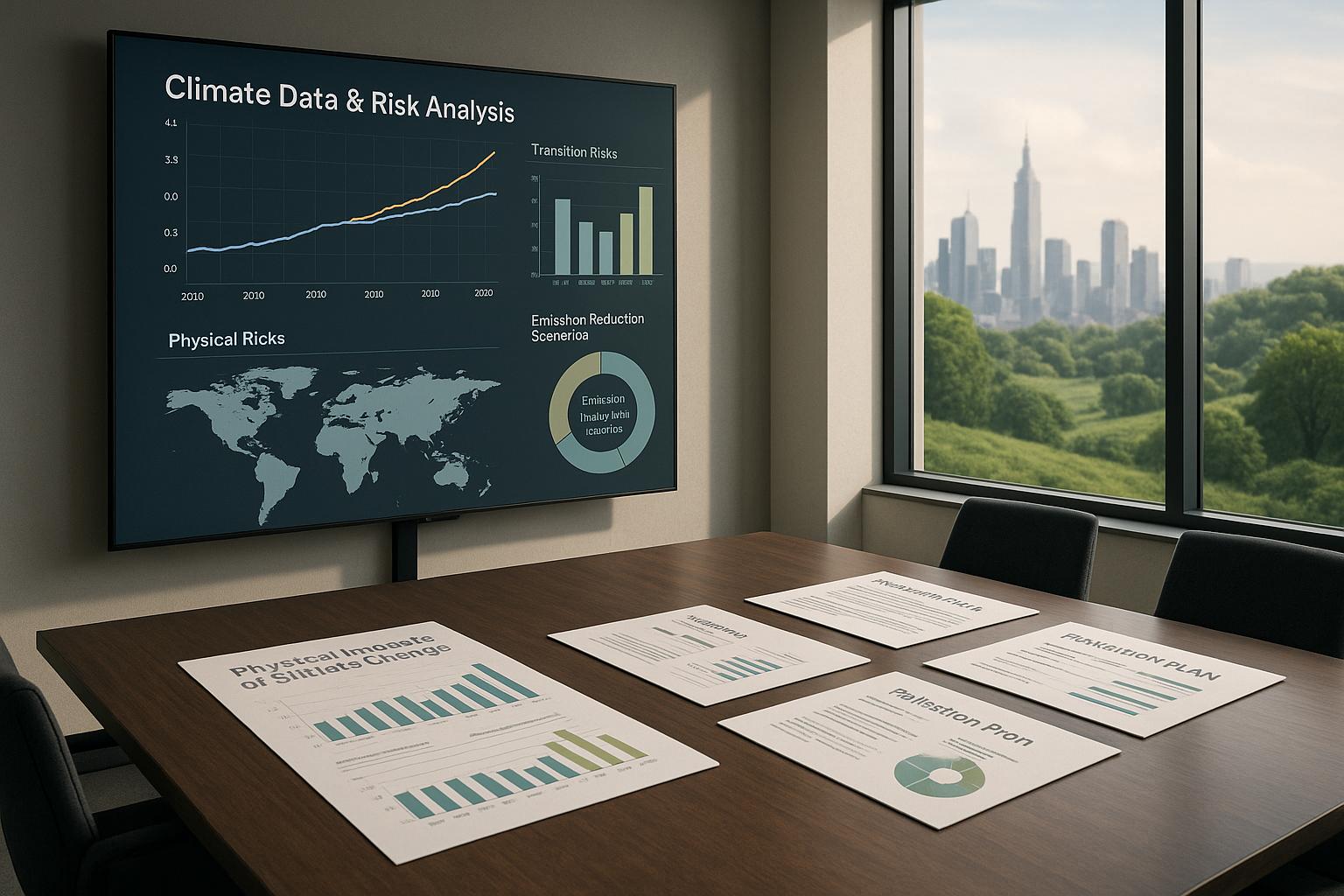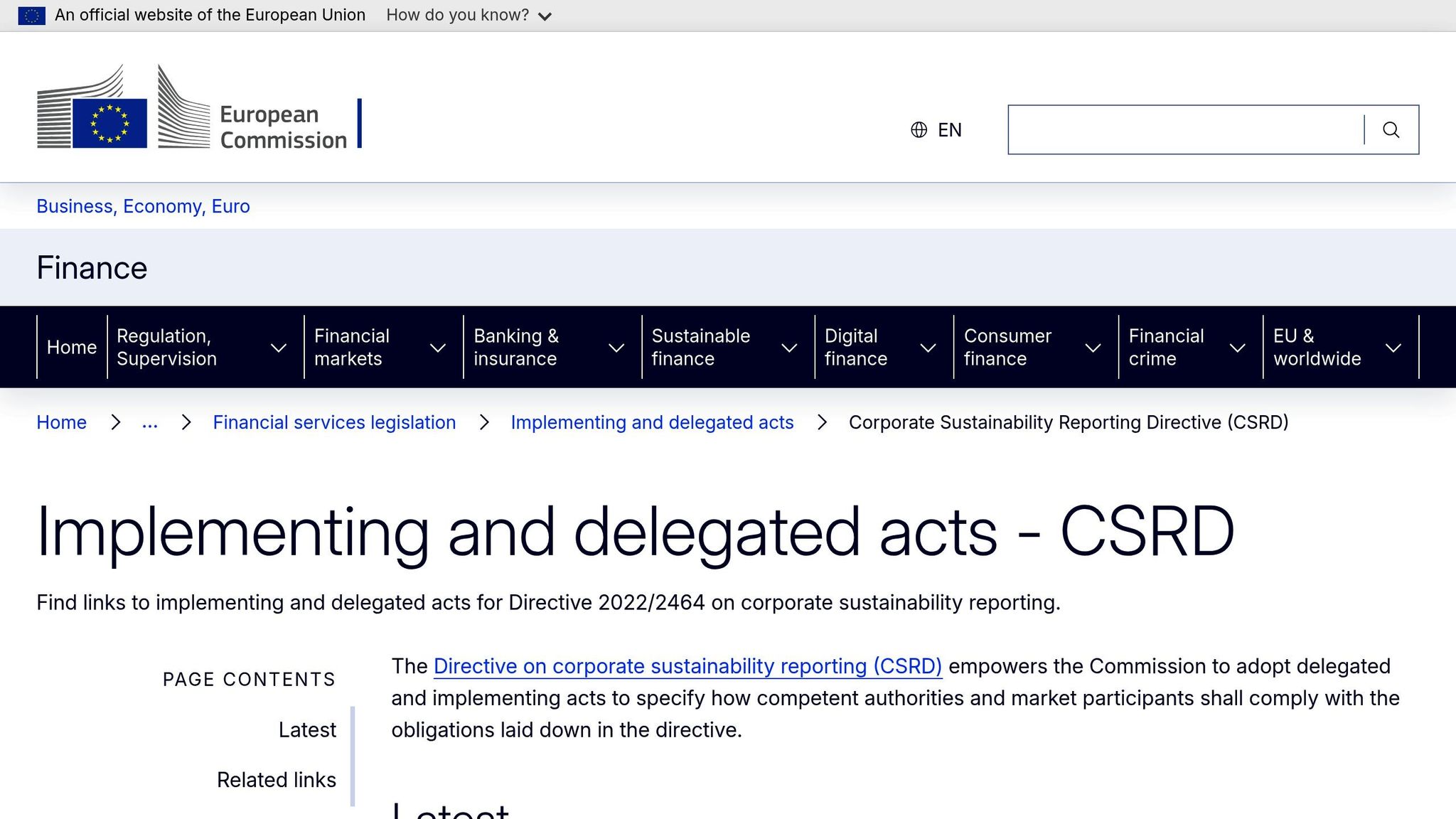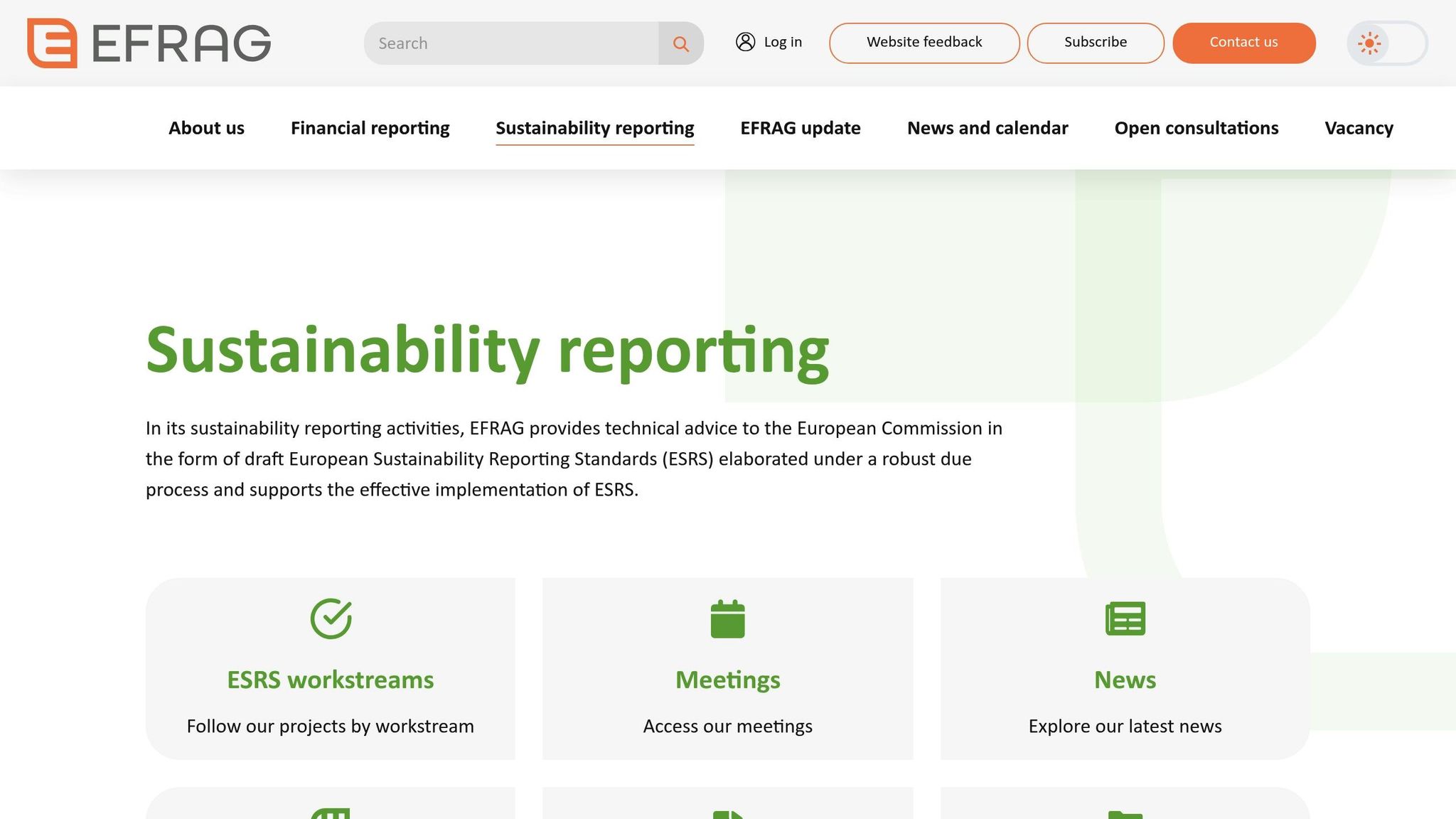Climate Risks and Resilience: Protecting EU Companies from Extreme Weather and Regulatory Challenges
Extreme weather events and climate risks cause billions in damages every year. Companies in the EU...
By: Johannes Fiegenbaum on 9/21/25 8:17 AM

The CSRD requires companies to analyze and report on climate risks in detail. It distinguishes between physical risks (e.g., floods, heat waves) and transition risks (e.g., rising CO₂ prices, changing customer preferences). A scenario analysis with two temperature scenarios is essential: 1.5°C and over 3°C.
Your task: identify, assess, and document risks according to the ESRS standards. This includes the financial assessment of risks, creating a risk inventory, and clear documentation. From 2026, all large companies in Germany must submit these reports. Small and medium-sized enterprises will follow from 2028.
Key points:
This guide helps you systematically meet the requirements, prioritize risks, and effectively integrate the results into your reporting.

The CSRD significantly expands the circle of companies required to report in Germany compared to the previous NFRD. Since 2024, large, capital market-oriented companies with more than 500 employees must report. From 2025, all large companies are required to submit a report if they meet at least two of the following three criteria: 250 employees, €40 million net revenue, or €20 million balance sheet total. These companies must submit their first reports according to CSRD standards in 2026 for the 2025 financial year.
Small and medium-sized capital market-oriented companies (SMEs) will also be subject to reporting requirements from January 1, 2026, with the option to defer reporting until 2028. Third-country companies operating in the EU will also fall under the CSRD from 2028 if they generate net revenue of more than €150 million in the EU and operate at least one subsidiary or branch office in the EU.

The European Sustainability Reporting Standards (ESRS) form the foundation for reporting under the CSRD. For climate risk analysis, ESRS 2 (General Disclosures) and ESRS E1 (Climate Change) are particularly important.
ESRS 2 focuses on materiality analysis. Companies must demonstrate how they integrate climate risks into their business strategy, risk management, and decision-making processes. The concept of double materiality plays a central role: both the company's impact on the climate (Impact Materiality) and the financial risks that climate change poses to the company (Financial Materiality) must be considered.
Under ESRS E1, companies must develop scenarios that include at least a 1.5°C target and a scenario with stronger temperature increases (over 3°C). These scenarios should incorporate both physical and transition risks and cover a time horizon of at least 30 years. A quantitative assessment of financial impacts is required where possible. If quantification is not feasible, companies must explain the reasons and provide qualitative descriptions instead. Complete and transparent documentation is essential in all cases.
To meet audit requirements, comprehensive documentation of all assumptions, methods, and calculations is necessary. A complete audit trail must ensure that all steps are traceable.
Governance documentation is a central component: it must record which bodies are responsible for overseeing climate risks, how often these bodies meet, and what expertise they bring. The role of the board or management in approving climate strategy and risk analysis must also be clearly described.
The risk inventory should systematically capture all identified physical and transition risks. For each risk, the data sources, assumptions, and assessment methods used must be documented. For physical risks, this includes climate projections – in Germany, often the ReKIS data from the German Weather Service – as well as site analyses for vulnerable facilities.
For transition risks, companies must disclose which CO₂ price paths, regulatory scenarios, and market assumptions they have used. The documentation should also explain how changing customer preferences, technological developments, and financing conditions could affect the business model.
The quantitative results must be presented in a standardized format. This means that impacts on revenues, costs, investments, and assets must be quantified for each risk area and scenario. Sensitivity analyses should illustrate how changes in key assumptions could influence the results.
Furthermore, the CSRD requires integration into financial reporting. The results of scenario analyses must be consistent with assumptions in the accounting and valuation of assets. If deviations occur, they must be explained and justified.
Physical risks refer to direct impacts of climate change. These can be divided into two categories: acute risks, such as heavy rainfall, heat waves, storms, or floods, and chronic risks, which can change operating conditions in the long term, such as through sustained temperature increases or rising sea levels.
Transition risks, on the other hand, arise from the transition to a low-emission economy. These include various areas:
The foundation of any sound risk analysis is structured data collection. Here are the most important steps:
With this data, you can systematically assess and prioritize risks.
A structured comparison framework helps evaluate different risk types and rank them according to their probability of occurrence and potential damage. The following table gives you an overview:
| Risk Type | Time Horizon | Main Metrics | Primary Data Sources | Assessment Approach |
|---|---|---|---|---|
| Acute physical risks | Short-term | Damage amount, downtime | DWD, regional climate data, insurance data | Probability |
| Chronic physical risks | Long-term | Cost increases, productivity losses | Climate projections, site analyses | Scenario analysis |
| Political transition risks | Medium-term | CO₂ costs, compliance costs | Legal texts, policy analyses | Regulatory analysis |
| Technological transition risks | Medium-term | Investment needs, market changes | Technology roadmaps, patent analyses | Technology assessment |
| Market transition risks | Variable | Revenue changes, margins | Market research, customer surveys | Market analysis |
For prioritization, a risk matrix that compares probability of occurrence and damage potential is recommended. Risks that show high values in both dimensions should be examined in particular detail.
Choosing appropriate scenarios is a central step: After creating the risk inventory, possible future developments are modeled that meet both scientific and regulatory requirements. Below, we examine scenarios for both physical and transition risks.
For modeling physical risks, many companies rely on the Representative Concentration Pathways (RCP) of the IPCC. One possible scenario could consider ambitious emission reductions and moderate climate changes. Another scenario assumes moderate climate protection measures that have noticeable but still controllable impacts on the climate system. Finally, there are models that assume a scenario without significant climate protection measures – with substantial global warming as a consequence.
To better capture site-specific challenges, regional projections, such as those from the German Weather Service (DWD), can also be used.
Transition risks depend heavily on political decisions and market dynamics. One scenario could assume that climate targets are implemented as planned and companies have sufficient time for adjustments. An alternative scenario could initially provide for moderate measures, followed by tightened regulatory interventions that require more intensive short-term adjustments. Another model combines inadequate climate policy with increasing physical risks, which could result in an exponential increase in transition risks.
Industry-specific developments and regulatory milestones – for example in the automotive or energy sectors – should also be considered in scenario analysis to develop realistic and practical models.
Based on the captured risk data, precise documentation of modeling assumptions is essential. All assumptions and methods should be recorded in a clear matrix.
For physical risks, it is recommended to document the climate models used, their spatial resolution, and the time horizon considered. When regional models, such as those from the German Weather Service, are used, the exact model version and relevant parameters should be specified.
For transition risks, it is important to clearly justify political and economic assumptions – such as CO₂ prices. Sensitivity analyses, where key parameters are varied and their effects documented, are also a valuable tool.
Furthermore, all underlying sources should meet scientific standards and be clearly identified in the documentation. A change history that makes all adjustments to assumptions and methods traceable ensures transparency. Finally, it is worthwhile to compare results with industry benchmarks to identify and explain possible deviations. This makes the analysis not only more comprehensive but also more robust.
To precisely integrate risks into your CSRD reporting, it is crucial to quantify the financial impacts after setting scenarios and assumptions. This involves analyzing how climate risks affect financial position, results, and cash flow. Below, we show how physical and transition risks can be financially assessed.
Physical risks can be quantified through an analysis of risk exposure, hazard, and vulnerability. For acute risks such as floods, you first identify vulnerable assets and their replacement values. Then you estimate the probability of damage based on historical data and climate projections. For example: A production site with an asset value of €50 million in a flood zone with an annual flood probability of 2% could lead to an expected annual damage if total loss is assumed.
Chronic risks, such as rising temperatures, require a different approach. Here you can, for example, project higher cooling costs. Water stress also becomes relevant by examining regional water availability – significant price increases are possible in affected areas.
After assessing physical risks, the analysis of transition risks follows. These arise from political, legal, technological, and market-related changes in the course of transitioning to a low-carbon economy. Scenario analyses, such as the NGFS climate scenarios, can serve as a foundation.
One approach is calculating additional CO₂ costs. Multiply your Scope 1 and Scope 2 emissions by projected carbon prices. A company with 100,000 tons of CO₂ equivalent and an expected CO₂ price of €100/ton would have to expect additional costs of €10 million. Indirect effects, such as passed-on costs from suppliers, should also be considered.
You analyze regulatory risks by assessing upcoming legislative changes. The EU Taxonomy, for example, can require significant investments. For building retrofitting measures, costs typically range between €200 and €500/m². With an office space of 50,000 m², you would need to plan for correspondingly high investments.
Double materiality analysis considers both the financial impacts of risks and the company's influence on environmental problems. You relate quantified climate risks to relevant financial metrics to identify significant influences. In parallel, you assess the extent to which the company contributes to environmental problems. Scope 3 emissions are particularly relevant here, as they often account for 70-90% of total emissions.
A materiality matrix helps compare financial and environmental impacts. Risks that show high values in both dimensions should be prioritized and disclosed in detail.
Additionally, sensitivity analyses are useful. These show how changed assumptions – such as a sharply rising CO₂ price – affect total costs. This allows you to check the robustness of your risk assessments and identify adjustment needs in risk management.
It is important to document your thresholds and assessment decisions transparently. External consultations can provide additional perspectives and strengthen the credibility of your analysis.
After determining the financial impacts, it's now about integrating these results into the final CSRD report. Systematic documentation and compliance with format requirements ensure audit conformity.
The developed results are entered in ESRS 2 (General Disclosures) and ESRS E1 (Climate Change). In ESRS 2, you describe under GOV-3 the role of administrative, management, and supervisory bodies in overseeing climate risks. Explain how often the board addresses this topic and what specific expertise is available.
Under SBM-3 (Material impacts, risks and opportunities), you list the identified physical and transition risks. For each risk, specify the time horizons (short-term: up to 5 years, medium-term: 5-15 years, long-term: over 15 years), as well as the affected business areas and geographical regions. You assign the calculated financial impacts to the corresponding categories, e.g.: "Revenue decline due to extreme weather events: €2,500,000 annually in a 2°C scenario".
In ESRS E1, you work on disclosures for points E1-1 to E1-9. Under E1-3, you define concrete risk mitigation measures, while under E1-4 you document the climate scenarios used, such as "RCP4.5 for physical risks" or "NGFS Net Zero 2050 for transition risks". You enter the Scope 1, Scope 2, and Scope 3 emissions under E1-6 and explain the data quality and calculation methods used.
All information must be documented in a clearly traceable audit trail. This includes detailed worksheets where you record sources, calculations, and assumptions, as well as plausibility checks performed.
The origin of data must be clear: Internal data – such as energy consumption or facility locations – should be marked with timestamps and responsibilities. External sources, such as climate projections from the German Weather Service or CO₂ prices from the European Energy Exchange, require complete references including retrieval date.
If you use climate models or software tools, document their version, configuration, and the parameters used. The documentation should be detailed enough that an external auditor can fully understand and reproduce the calculations.
Compare your results with industry benchmarks or scientific studies. If deviations occur, you must justify them – for example, through particularities of your business model or regional differences.
Follow German format standards: Currency amounts are in euros with German formatting ("€1,250,000.50"), dates use the format DD.MM.YYYY ("31.12.2024"), temperatures are given in Celsius, areas in square meters or hectares, distances in kilometers, and weights in kilograms or tons.
Use comma as decimal separator and periods as thousand separators. Example: "1,500.0 t CO₂" for a CO₂ amount of one thousand five hundred tons. Also use the comma for percentages: "12.5%". Mark negative values with a minus sign before the number: "-€2,500,000.00".
Create a bilingual glossary for technical terms, as international investors often expect English terms. Terms like "Scope 1 emissions" or "Physical Risk" should be explained in both German and English.
The report structure follows the order of ESRS sections and uses German headings. Thus "Material impacts, risks and opportunities" becomes "Wesentliche Auswirkungen, Risiken und Chancen". Ensure that cross-references between sections work correctly and page numbers are accurate.
For graphics and tables, use German labels. Axis labels in diagrams should be in German, e.g., "Jahr" instead of "Year" or "Millionen Euro" instead of "Million EUR". Table headings also follow German spelling with appropriate capitalization.
With these steps, your CSRD report is complete and ready for audit. The next section covers how you can further develop and optimize your strategy.
The complete CSRD report is not an endpoint, but rather the starting point of an ongoing process. The scenario analysis must be regularly updated to keep pace with dynamic climate conditions and new regulatory requirements. This continuous development directly connects your existing insights with the upcoming challenges of CSRD reporting.
An important step: Establish an annual review cycle for your risk analysis. As climate science is rapidly evolving, new findings can influence your previous assumptions. Plan to update your scenarios by October each year at the latest, so there is sufficient time to complete reports by April 30 of the following year.
Build internal expertise to work more efficiently in the long term. While external consultants can help with getting started, having your own expertise makes you more flexible. Two of your employees should be trained in the methods and tools used to ensure continuity. This internal knowledge makes it easier for you to integrate climate-related risks directly into your business strategy.
Put the insights gained into targeted decisions. The identified risks should not only be documented but actively considered – whether in site planning, supplier selection, or new product development. Companies that integrate climate risks into their strategic planning are better prepared for upcoming challenges.
Stay prepared for future changes to the CSRD. The standards will continue to evolve, and additional reporting obligations could follow. Therefore, document your processes in detail so you can adapt quickly.
Beyond technical implementation, one thing is crucial: Communicate your results transparently. Stakeholders expect well-founded information on climate risks. A clearly structured and well-executed scenario analysis process can not only secure trust but also provide a competitive advantage in an increasingly sustainability-oriented business world.
To conduct a scenario analysis in line with the CSRD, you should first clearly define the scope of your reporting and conduct a materiality assessment. This involves identifying the material physical and transition risks that are relevant to your company.
The next step is the risk and scenario analysis, where you assess possible future developments and their potential impacts on your business. It is important to rely on scientifically sound methods and proven approaches to develop scenarios that are both realistic and robust.
This approach not only helps meet CSRD requirements but also contributes to strategically integrating sustainability aspects into your corporate planning.
Physical risks encompass the direct consequences of climate change, such as extreme weather events, rising sea levels, or higher temperatures. Such developments can cause significant damage to infrastructure, assets, or supply chains – and thus severely disrupt companies' operational capacity.
Transition risks, on the other hand, arise from the transition to a climate-neutral economy. These include new legal requirements, technological developments, or changed market demands that can put pressure on existing business models. Companies must adapt to these changes to remain successful in the long term.
The key for companies lies in recognizing physical risks early and taking measures to withstand the consequences of climate change. At the same time, it is important to strategically address transition risks to adapt to regulatory and market-side changes – and thus secure their own competitiveness.
Double materiality plays a key role in CSRD reporting. It involves considering two perspectives: First, how your company's activities affect the environment and society (the so-called 'inside-out' perspective). Second, how external sustainability factors can influence your financial situation ('outside-in' perspective).
To successfully implement double materiality, the following steps are helpful:
When double materiality is clearly integrated into your reporting, it not only creates transparency but also strengthens trust in your sustainability strategy.

ESG & sustainability consultant specializing in CSRD, VSME, and climate risk analysis. 300+ projects for companies like Commerzbank, UBS, and Allianz.
More aboutExtreme weather events and climate risks cause billions in damages every year. Companies in the EU...
How well do you know the climate risks in your supply chain? Hidden climate exposures—risks that...
China's new climate targets: Challenge and opportunity for Europe's companies - What the...